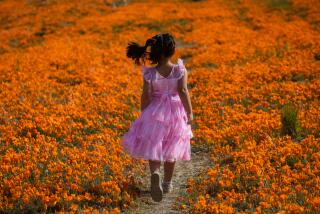Climate change could slash snowfall in Southern California mountains

Climate change is likely to wipe a lot of the white from those postcard winter scenes of Los Angeles ringed by snow-capped mountains, according to new research.
A UCLA study released Friday projects a significant decline in snowfall on the ranges that provide a dramatic backdrop to urban Southern California.
By mid-century, the amount of snow draping the mountains could decrease 30% to 40%, researchers say. If greenhouse gas emissions continue unabated, the ranges could lose two-thirds of their snow by century’s end.
That means fewer and fewer days in coming decades will reflect the classic images of sun and snow that have idealized life in Southern California since 1920s citrus-crate labels beckoned to Easterners.
“It kind of cuts to our identity,” said Jonathan Parfrey, a commissioner with the Los Angeles Department of Water and Power who is also executive director of Climate Resolve, a local nonprofit concerned with climate change.
The research, funded by the U.S. Department of Energy and the National Science Foundation, is the second study in a series examining the effects of climate change on the Los Angeles region.
Scientists at the UCLA Department of Atmospheric and Oceanic Sciences downscaled 30 global climate-change models to the regional level, factoring in local topography. Professor Alex Hall, a coauthor of the study, said the regional simulations allowed researchers to examine the impacts of rising temperatures at an exceptionally small scale.
The study employed two climate change scenarios.
Under the “business-as-usual” scenario, global greenhouse-gas emissions continue to rise throughout this century, pushing up temperatures.
Under the second, “mitigation” scenario, emissions peak within the next two decades and then steadily decline, limiting the temperature climb.
Researchers compared the results with snowfall from 1981-2000, when an average of more than 10 inches a month could fall during the winter at high elevations of the Tehachapi, San Emigdio, San Gabriel, San Bernardino and San Jacinto mountains. More than 40 inches a month can coat the peaks.
Snow will disappear from the lowest elevations that now receive it, the study concluded.
If greenhouse-gas emissions are curbed, snow loss at higher elevations would stabilize at about 30% by mid-century. But if emissions continue to climb — forcing more warming — snowfall would drop 40%. By the final decades of the century, it would only be a third of present-day amounts.
The decline would be particularly noticeable in the northern hills of the San Gabriels and the area between the San Gabriel and Tehachapi ranges, the researchers found.
Recreational effects could be substantial. At Wrightwood’s Mountain High ski area, which bills itself as Southern California’s “closest winter resort,” annual snowfall could drop from about 87 inches to 52 inches by mid-century and plunge to 33 inches by the end of the century.
“Unless we make some dramatic changes in our greenhouse-gas emissions, there’s just not going to be the same options available,” Parfrey said, referring to the classic Southland boast that outdoors enthusiasts can surf in the morning and ski in the afternoon.
The fact that more winter precipitation will fall as rain rather than snow could also have implications for flood control, storm-water capture and wildlife habitat. “Those are probably some things to look at,” Hall said, adding that his research did not explore those issues.
State water managers are greatly concerned about the expected drop in the Sierra Nevada snowpack, which acts as a natural reservoir for much of California. But Richard Atwater, a former general manager of the Inland Empire Utilities Agency, said snow loss in Southland mountains was of less concern.
“Here the snow is pretty iffy anyway, and it’s irregular,” said Atwater, who heads the Southern California Water Committee. “It doesn’t affect our capturing and recharging into groundwater basins, whether it’s on the San Gabriel River or the Santa Ana River.”
“The bigger issue,” he added, is “that with climate change, we’re going to have more intense storms, flashier storms. That’s just so much harder to capture.”







